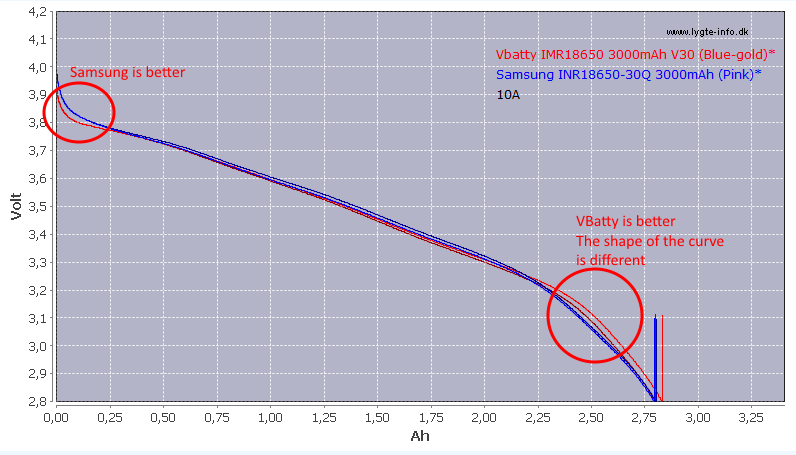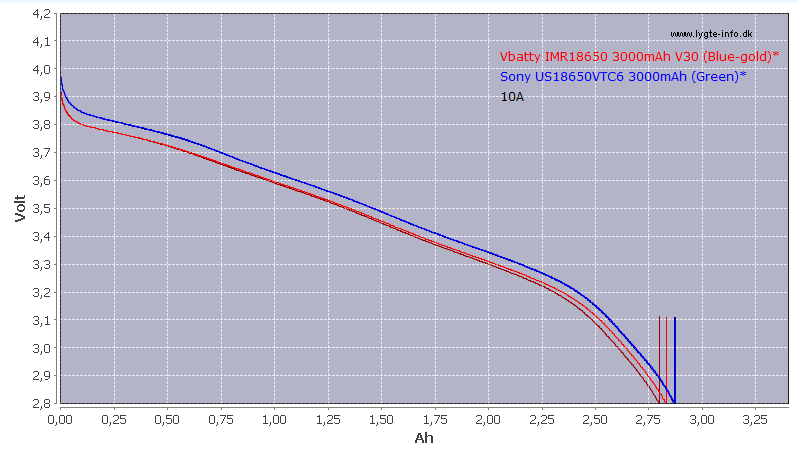
The shape of the curve is slight different.

The shape is the same, but Ri is different.


The shape of the curve is slight different.

The shape is the same, but Ri is different.

Thanks for pointing that out. I prefer to have it BETTER in the beginning. I change my batteries every 15/20 minutes for my single cell modded lights.
When I get home the voltages range b/w 3.75/3.85. They never get low, would never drain to a point where Vbatty would have a slight advantage ~ 3.2V!
I am no authority on lithium ion cells I am just a lowly technician. However I am very curious and have been for some time now and you guys seem to be the people to answer.
Please correct me anywhere that I am wrong as I said I can fix or build anything, I am just beginning to learn how important the differences in our choice of cells really is.
With most things being pretty much equal i.e. contents of the cell itself, materials used and if it is unprotected then there is very little left that can be changed. 30q as an example only, if another company wishes to compete with that cell there are only very small variances that could even be possible. If there is no electronic control and I build a cell with the same or as close to the same materials as a 30q is manufactured from. They will appear even in tests to be the same cell.
I guess the easiest thing to ask is just how much can be changed in modern 18650 cells that could make them better?
Again please pardon my ignorance, these are the the last pieces of the puzzle that I need grow and expand my mods. My dad was a first class engineer but passed away before teaching me all I would need to know about electricity.
I have a question HKJ!
What is Ri?
A lot of people is working on that, small difference in the composition of the chemicals can have significant impact on cell performance.
I added images of the cell tops to my above post.
That is internal resistance, sometimes you write IR for Internal Resistance, but above I swapped the letters (that is also a legal way to write it).
They could be getting drained lower then that. When the load is switched off the voltage recovers some. If you have a opus charger or liito 500 run a plain discharge cycle. Opus goes to 2.8 volts come back to the charger 30-60 mins later voltage will be 3.3-3.4 and worn cells even higher. On my 30q drained to 3.0 under load in another device with 3.0 cut off recover to about 3.27-3.3 with no load
It actually begins to recover as soon as the load is removed. Watch the opus go from 2.8 to 3+ 30s later when it updates the voltages. Every 30seconds it updates
Look at HKJ graphs when he stops a cell because of tempature you see the voltage recover instantly. So you are going lower. Nothing dangerous though. 2.5 is the common cut off. Some lg cells are rated to 2.0 hg2 spec sheet goes to 2.0 to get the 3000mah rating
I understand that once the load is taken off the battery will rebound. So maybe they were @ 3.69V/3.79V then recovered to 3.75v/3.85v by the time I got home. Still no where near ~ 3,2v where the graph shows Vbatty w/ a little advantage.
My point is I NEVER need to drain the battery that low because I LOVE MAX OUTPUT! Therefore I change the battery before it is close to being depleted [as stated above] so I can enjoy max output! :sunglasses:
In addition, there is probably a GOOD chance my batteries will last longer when they are not drained so low. In fact it has already happened w/ many of my batteries that are 4 years plus and still going because I NEVER let them go below 3.60V and mostly charged b/w 3.65 and 3.85v. ![]()